Conquer That Pesky Film on Top of Your Pool Water
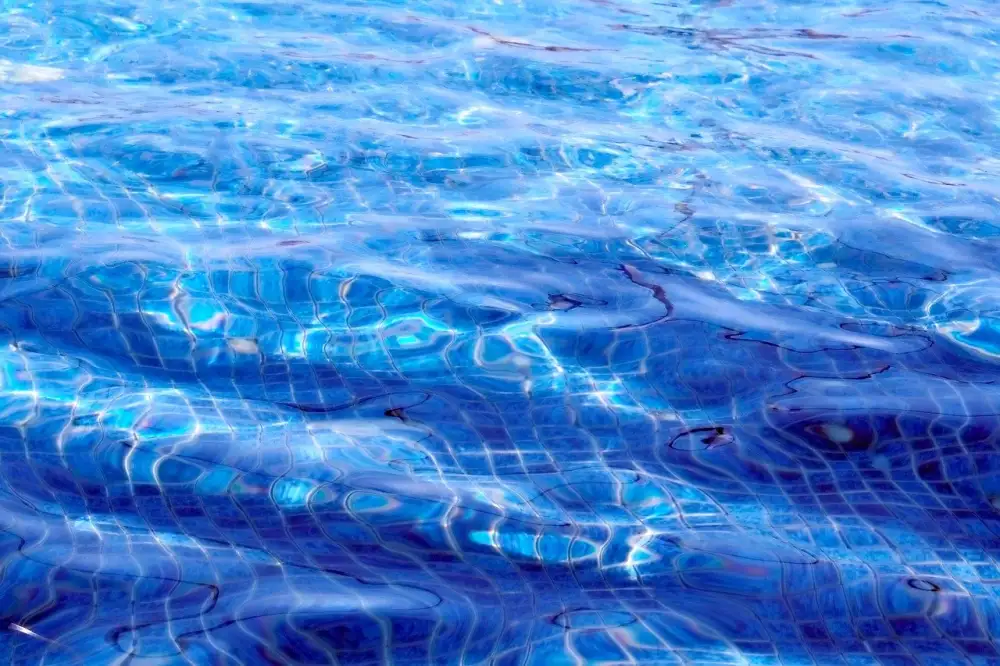
- What is that film on my pool?
- Common causes of pool film
- Pollen and organic debris
- Sunscreen, lotions, and body oils
- Algae growth and buildup
- Ineffective water circulation
- Imbalanced pool chemicals
- Health risks of pool film
- Preventing pool film formation
- Regular pool cleaning routine
- Showering before swimming
- Proper pool water testing
- Maintaining balanced chemistry
- Effective solutions for pool film
- Seeking professional pool help
What is that film on my pool?
That icky film on your pool's surface? It's not always as simple as "ew, gross!" It can be a telltale sign of several things, and understanding the cause is key to getting your pool sparkling again.
One common culprit is pollen. Yep, those tiny particles that make you sneeze can also create a yellowish-green film on your pool. Dust and dirt blown in by the wind contribute too, leaving behind a dull, grimy layer.
But sometimes, the film is more than just environmental. Body oils, sunscreen, hair products, and even makeup can wash off swimmers and create a slick, oily residue. This is especially true if your pool sees a lot of action!
Then there's the big one: algae. A thin, almost invisible film can be an early warning sign of an impending algae bloom. If you let it go, the film can thicken, turn green, and even become slimy.
So, how can you tell what you're dealing with? Try this: grab a white cloth and skim the surface. Pollen and dirt will usually collect on the cloth. If the cloth remains clean but the water still looks filmy, it's likely body oils or other contaminants. If you suspect algae, look for a greenish tint or slippery texture.
Common causes of pool film
Pool film can be a real drag. It makes your pool look dirty, even if the water underneath is crystal clear. Several things can cause that pesky film, so understanding the culprits can help you get rid of it and keep your pool sparkling.
One of the most common causes is organic waste. Think body oils, lotions, sunscreen, hair products, and even pollen and leaves. These things break down in the water and create a slimy film on the surface.
Another culprit is mineral buildup. If you have hard water, you're probably familiar with calcium and magnesium deposits. These minerals can also accumulate on the pool surface, creating a scummy layer.
Believe it or not, your pool chemicals might also be contributing to the problem. If the pH, alkalinity, or calcium hardness levels are off, it can throw off the water balance and lead to film formation.
Finally, don't underestimate the power of the environment. Airborne contaminants like dust, dirt, and pollution can settle on the pool surface and contribute to that filmy layer.
Pollen and organic debris
Pollen and organic debris are the most common culprits behind that unsightly film or layer you often see on your pool water. Think of your pool as a giant magnet for everything light enough to be carried by the wind. Pollen from trees, flowers, and grasses, along with leaves, insects, and even bird droppings, can all end up in your pool, forming an unwelcome layer on the surface. This layer not only looks bad, but it can also clog your pool's filtration system, reduce the effectiveness of your chlorine, and even create a breeding ground for bacteria and algae.
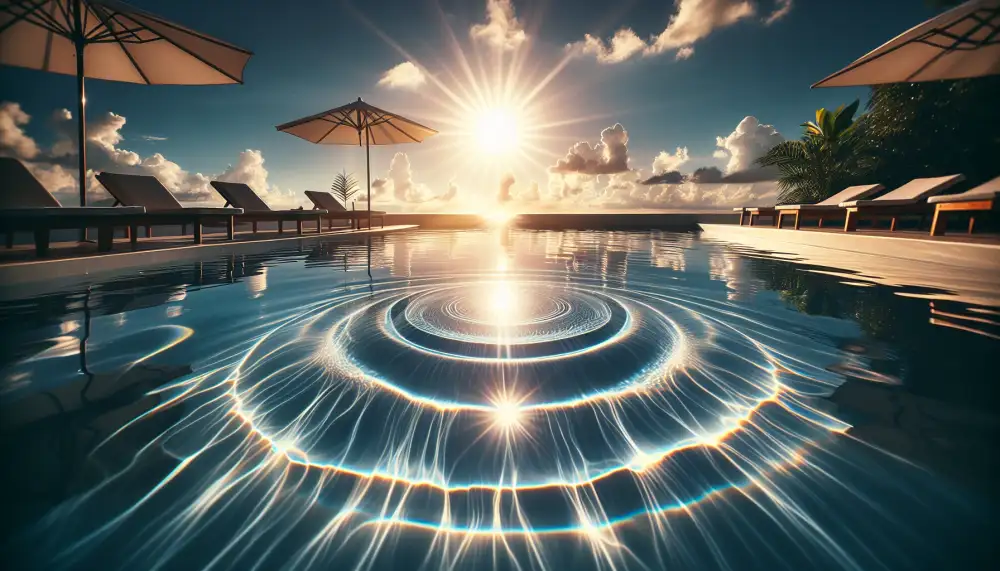
During peak pollen season or after a windy day, you'll likely notice a more pronounced film on your pool. This is because pollen and other organic debris contain oils and fats that aren't water-soluble. Instead of sinking, they float on the surface, creating that oily or scummy layer. While regular skimming and cleaning can help manage this issue, using a good quality pool cover when the pool's not in use can significantly reduce the amount of pollen and debris that ends up in your water.
Sunscreen, lotions, and body oils
Sunscreen, lotions, and body oils can wreak havoc on your pool's water chemistry and create an unsightly film on the surface. These products often contain oils, fragrances, and other chemicals that are not designed to break down in chlorinated water. As a result, they can build up on the surface, creating a greasy layer that not only looks bad but can also clog filters and reduce the effectiveness of your pool's sanitation system.
This buildup is often most noticeable after a busy day of swimming when a combination of these products has been introduced to the water. The film might appear as a milky or oily layer and can even cause the water to look cloudy. In extreme cases, it can even make the pool surface slippery, posing a safety hazard.
To minimize this issue, shower before entering the pool to remove excess lotions and oils. Opt for waterproof sunscreen labeled "reef-safe" or "pool-friendly," as these are less likely to contain the ingredients that cause buildup. Regularly skimming the pool's surface and maintaining proper chlorine levels can also help combat the issue.
Algae growth and buildup
A common issue for pool owners is a layer of film or residue on the water's surface. While it might appear as simple dirt, it's often due to algae growth and buildup. Algae are microscopic organisms that thrive in warm, sunny environments, making pools an ideal breeding ground.
When your pool water lacks proper sanitation or circulation, algae can multiply rapidly, leading to a noticeable film. This film can range in color from green and yellow to even black or brown, depending on the type of algae present.
Besides being unsightly, algae buildup can clog filters, reduce water clarity, and even create a slippery surface, posing safety hazards. Regularly testing your pool water's chemical balance, especially chlorine and pH levels, is crucial in preventing algae growth.
Additionally, proper pool circulation and filtration help distribute chemicals evenly and remove debris that algae feed on. If you notice a persistent film on your pool water, it's essential to address it promptly to maintain a clean, safe, and enjoyable swimming experience.

Ineffective water circulation
Ineffective water circulation is a common culprit behind that unsightly film or layer of residue you might find on the surface of your pool water. Think of your pool's circulation system as its heart and blood vessels. Just like our bodies need proper blood flow to stay healthy, your pool needs water to circulate effectively to remain clean and inviting.
When the water doesn't move enough, dead algae, pollen, body oils, and even sunscreen can accumulate in certain areas, particularly along the waterline. This buildup forms that dreaded scum line and contributes to the overall cloudiness or film you might see.
Several factors can contribute to poor circulation. A clogged filter, for instance, restricts water flow, much like a clogged artery. Similarly, issues with your pool pump, like a failing motor or impeller problems, can significantly hinder circulation. Even something as simple as pointing your return jets in the wrong direction can create dead zones where water stagnates.
Imbalanced pool chemicals
Imbalanced pool chemicals can lead to various issues, including unsightly films and residues on the water's surface. These problems not only make your pool look unappealing but can also affect its safety and functionality.
One common culprit behind a film on top of the pool water is an imbalance in the water's surface tension. This imbalance is often due to high levels of body oils, lotions, and cosmetics, combined with insufficient chlorine levels. When these substances accumulate, they create a thin layer on the surface, preventing proper water circulation and filtration.
Another reason for a film or residue could be an imbalance in the pool's pH and alkalinity levels. High pH, also known as alkalinity, can cause calcium and other minerals to precipitate out of the water, forming a white, scaly residue on the pool surface and equipment. Conversely, low pH can lead to etching of the pool surfaces and corrosion of metal components.
Addressing these issues involves testing your pool water regularly and adjusting the chemical levels as needed. Maintaining proper chlorine levels helps break down organic contaminants, while balancing pH and alkalinity prevents mineral buildup and surface scaling. Using a pool skimmer regularly to remove debris and adding a clarifier to clump together smaller particles can also help maintain a clean and sparkling pool surface.
Health risks of pool film
Pool film, that layer of gunk that can develop on the surface of your pool water, isn't just unsightly, it can also pose health risks. This film often comprises body oils, lotions, sunscreen, pollen, and even bacteria. As these substances accumulate, they create a breeding ground for microorganisms, some of which can be harmful to human health.
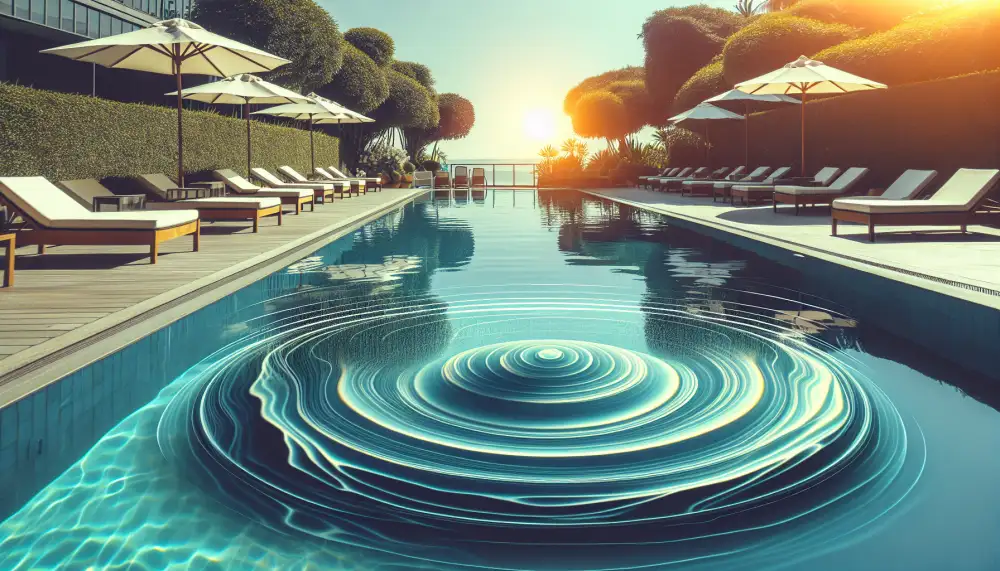
| Feature | Organic Film | Inorganic Film |
|---|---|---|
| Appearance | Often oily or greasy, with a possible rainbow sheen | Can appear as a fine dust, scale, or discoloration |
| Cause | Body oils, lotions, pollen, leaves, insects | Hard water deposits (calcium, magnesium), copper from algaecides |
Swimmers may experience skin irritations like rashes, itchiness, or even infections from coming into contact with a contaminated pool film. Eye infections are another concern, as bacteria can easily transfer from the water to the eyes. For individuals with respiratory issues like asthma, inhaling the fine droplets of contaminated water can trigger breathing difficulties.
Beyond these immediate risks, a neglected pool film can contribute to the growth of more serious waterborne pathogens, including E. coli and Cryptosporidium. These pathogens can cause gastrointestinal illnesses with symptoms like diarrhea, vomiting, and stomach cramps.
Regular pool maintenance, including skimming the surface and proper chemical treatment, is crucial to prevent the formation of pool film and protect the health of swimmers.
Preventing pool film formation
Pool film is a common problem that can make your pool look dirty and uninviting. It's that greasy or oily layer that sits on the surface of your pool water. It's not only unsightly, but it can also clog up your filter and make it harder to keep your pool clean. The good news is that preventing pool film is relatively easy if you know what to do.
One of the biggest culprits of pool film is organic waste. This includes things like body oils, sunscreen, hair products, and even leaves and grass clippings. When these substances get into your pool water, they don't always dissolve completely. Instead, they can create a thin film on the surface. To combat this, shower before entering the pool and make sure to skim the surface of your pool regularly to remove any debris.
Another common cause of pool film is the use of incorrect chemical levels. If your pool water isn't properly balanced, it can create an environment where oils and other substances are more likely to stick together and form a film. Test your pool water regularly and adjust the pH, alkalinity, and calcium hardness levels as needed.
Finally, make sure your pool's filtration system is working properly. Your filter is responsible for removing dirt, debris, and other contaminants from your pool water. If your filter is dirty or clogged, it won't be able to do its job effectively, and this can lead to a buildup of film on the surface of your pool. Clean your filter regularly and replace it as needed.
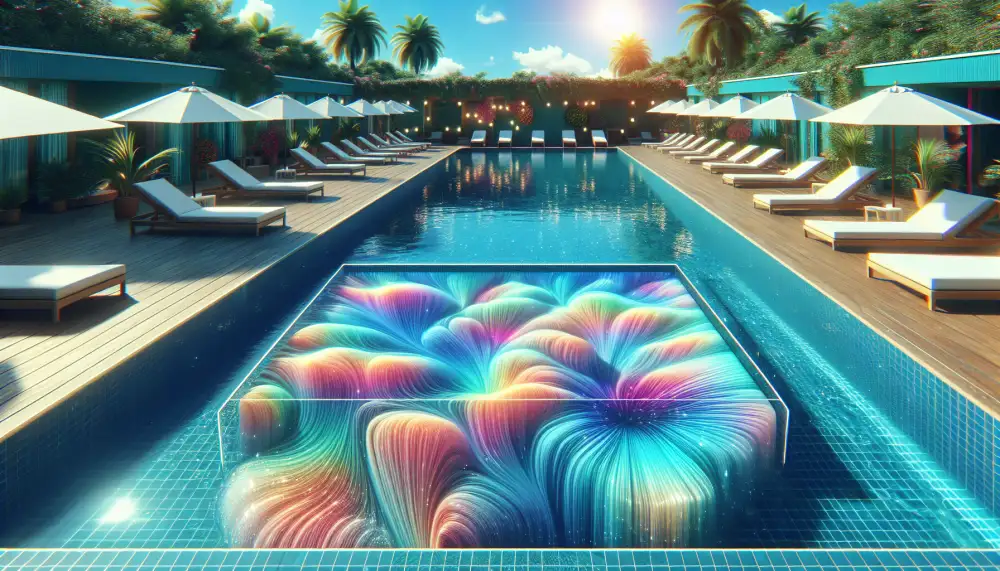
By following these simple tips, you can help prevent pool film from forming in the first place and keep your pool water sparkling clean all season long.
Regular pool cleaning routine
A regular pool cleaning routine is your best defense against that unsightly film or layer of residue that can form on the water's surface. This film, often caused by pollen, dust, body oils, or even sunscreen, not only looks bad but can also harbor bacteria and reduce your pool's sanitation effectiveness.
Start by skimming the surface of your pool daily with a leaf net to remove any floating debris. This simple step prevents the buildup of organic matter that contributes to the film. Next, use a pool brush to scrub the walls and floor of the pool at least once a week. This removes any dirt or grime that could be adding to the problem.
Your pool's filtration system plays a crucial role in keeping the water clean and clear. Run your filter for at least 8 hours each day, and more often during periods of heavy use or after adding chemicals. Regularly backwash your filter to remove trapped debris and ensure optimal performance.
Finally, maintaining proper water chemistry is essential. Ensure your pool's pH level stays between 7.2 and 7.8. This balanced range prevents scaling and makes your chlorine more effective at sanitizing the water. Shock your pool weekly to destroy any lingering bacteria or contaminants that contribute to film and residue buildup.
Showering before swimming
Many people believe that showering before swimming is unnecessary, especially if they're just going to get wet anyway. However, showering before entering a pool is crucial for maintaining hygiene and water quality. Think about the layer of sweat, lotion, sunscreen, and other personal care products we have on our skin. When we jump into the pool without rinsing off, all those substances wash off and contribute to the formation of that icky film you sometimes see on the water's surface. This film, often called "pool scum," isn't just visually unappealing, it's also a breeding ground for bacteria and can reduce the effectiveness of the pool's chlorine.
By showering with soap and water before swimming, we remove a significant portion of these contaminants, making the pool a cleaner and healthier environment for everyone. It's a simple act of courtesy that goes a long way in ensuring a more enjoyable swimming experience.
Proper pool water testing
A clean and sparkling pool is a joy, but what happens when you notice a film or residue on the water's surface? This is where proper pool water testing comes in. It's not just about aesthetics; that film could indicate underlying issues affecting your pool's health and your enjoyment.
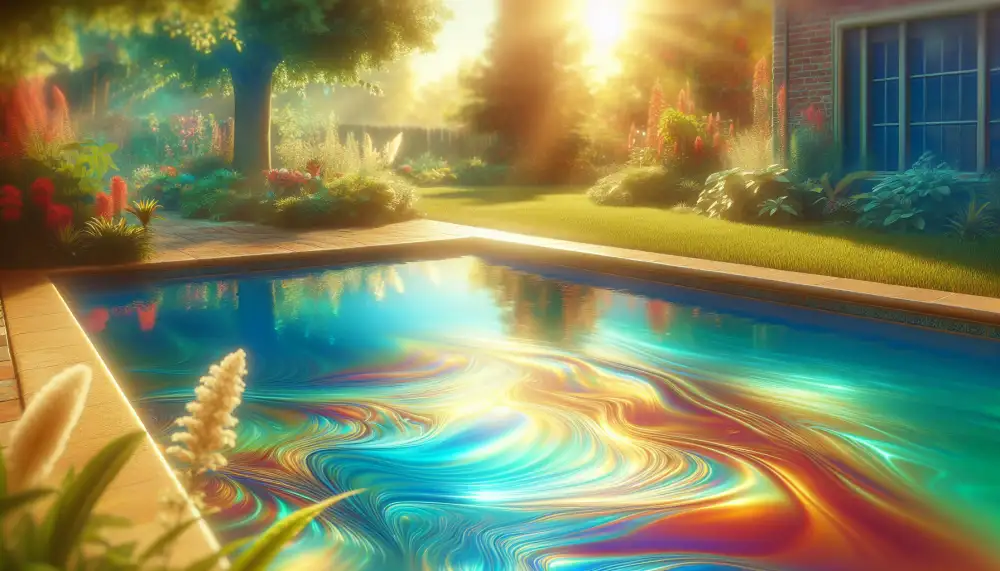
Start with a visual inspection. Is the film oily, dusty, or does it resemble scales? Each provides clues about the potential culprit. Oily film often points to sunscreen, body oils, or even decaying organic matter. A dusty layer might be pollen, dirt, or debris blown in by the wind. Scale-like residue could indicate high calcium hardness levels in your water.
Next, grab your water testing kit. This is non-negotiable. Regularly testing your pool water for pH, alkalinity, calcium hardness, and sanitizer levels is crucial. An imbalance in any of these can contribute to that pesky film. For example, high pH can reduce chlorine's effectiveness, leading to a buildup of oils and lotions. Similarly, high calcium hardness can cause scaling, leaving a rough residue on the surface.
Don't rely on guesswork. Your test kit will provide specific readings, allowing you to make informed adjustments to your pool's chemical balance. If you're unsure about interpreting the results or addressing the issue, consult a pool professional. They can provide tailored advice and solutions based on your pool's specific needs.
Maintaining balanced chemistry
Maintaining crystal-clear pool water is a constant battle against contaminants and imbalances. One common issue that plagues pool owners is the formation of an unsightly film or layer on the water's surface. This film, often accompanied by a greasy or oily sensation, is a telltale sign of imbalanced water chemistry.
Several factors contribute to this frustrating phenomenon. Organic compounds, such as body oils, lotions, and even pollen, can accumulate on the water's surface, creating a barrier that prevents proper water circulation and filtration. When these substances mix with chlorine, they can form chloramines, which not only emit a strong chlorine odor but also reduce chlorine's effectiveness as a sanitizer.
Another culprit is calcium carbonate, a mineral that can precipitate out of the water when the pH and calcium hardness levels are too high. This precipitation forms a white, scaly residue on the pool surface, contributing to the film's formation.
To combat this issue, a multi-pronged approach is necessary. Regularly skimming the water's surface with a net removes debris before it can break down and contribute to the film. Maintaining proper water circulation and filtration ensures that contaminants are constantly being removed. However, the key to truly banishing the film lies in achieving and maintaining balanced water chemistry.
Testing the water regularly and adjusting the pH, alkalinity, and calcium hardness levels as needed prevents mineral buildup and creates an environment where chlorine can effectively sanitize the water. Shocking the pool periodically with a high dose of chlorine oxidizes organic contaminants, breaking down the film and restoring water clarity.
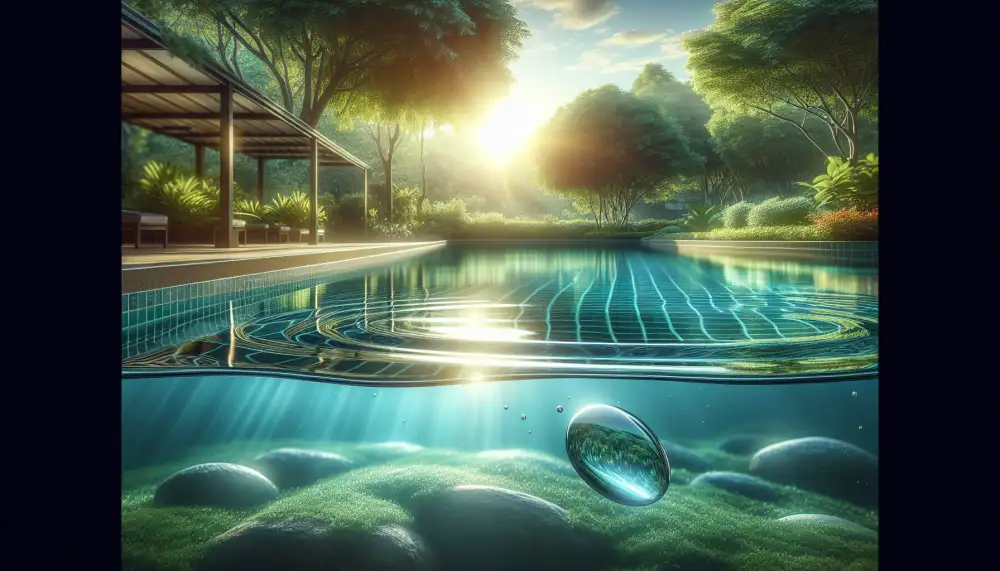
Effective solutions for pool film
Pool film can be a real bummer. It's that icky layer of stuff that sits on top of your pool water, making it look cloudy, dull, and uninviting. But what exactly is pool film, and what's the best way to get rid of it?
Pool film is a mixture of organic and inorganic contaminants that accumulate on the surface of your pool water. Think body oils, sunscreen, lotions, pollen, leaves, and even tiny insects. These substances don't always dissolve completely in the water and can create that greasy, oily, or scummy layer we all dread.
So, how do you win the battle against pool film? Here are some effective solutions:
Skim, skim, skim: Regularly skimming the surface of your pool with a skimmer net is your first line of defense. It removes floating debris before it can sink and contribute to film buildup.
Shock your pool: Shocking your pool with a chlorine-based shock treatment helps break down organic contaminants like body oils and sunscreen, which are major contributors to pool film.
Use an enzyme-based cleaner: Enzyme-based pool cleaners are specifically designed to break down non-living organic waste, making it easier for your filtration system to remove.
Run your filter regularly: Your pool filter is your best friend when it comes to keeping your water clean and clear. Make sure to run it for at least 8 hours a day, especially during swimming season.
Maintain proper water chemistry: Balanced water chemistry is crucial for preventing and eliminating pool film. Regularly test your water and adjust the pH, alkalinity, and chlorine levels as needed.
Remember, prevention is key! By being proactive with your pool maintenance and using the right products, you can keep your pool water sparkling clean and film-free all season long.
Seeking professional pool help
If you're noticing a persistent film on the surface of your pool water, or a layer of residue that just won't seem to go away, it might be time to call in the pros. While some pool maintenance tasks can be handled by diligent owners, certain issues require the expertise and equipment of a professional pool service.
Here's why seeking professional help for film and residue problems is often the best course of action:
Accurate Diagnosis: Experienced pool technicians can quickly identify the source of the problem. Is it an issue with your water chemistry, a buildup of body oils and lotions, or something else entirely? A correct diagnosis is key to effective treatment.
Specialized Equipment: Professionals have access to powerful pumps, vacuums, and filtration systems that can remove stubborn films and residue more effectively than standard homeowner equipment.
Chemical Expertise: Balancing pool chemicals can be tricky. Professionals have the knowledge and tools to adjust your water chemistry precisely, ensuring the problem is addressed without causing further imbalances.
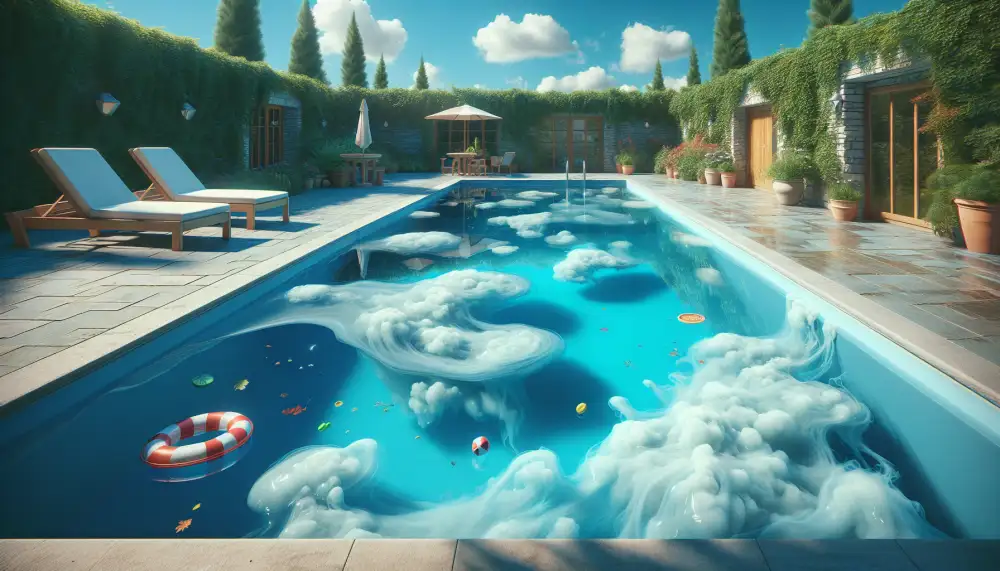
Long-Term Solutions: A professional pool service can not only remove the existing film or residue but also advise you on preventative measures to keep your pool water sparkling clean in the future. This might involve adjusting your cleaning routine, recommending specific products, or addressing underlying issues with your pool's filtration system.
Don't let a pesky film or stubborn residue ruin your pool enjoyment. Contact a reputable pool service in your area and let the experts restore your pool to its pristine glory.
Published: 29. 06. 2024
Category: Food



